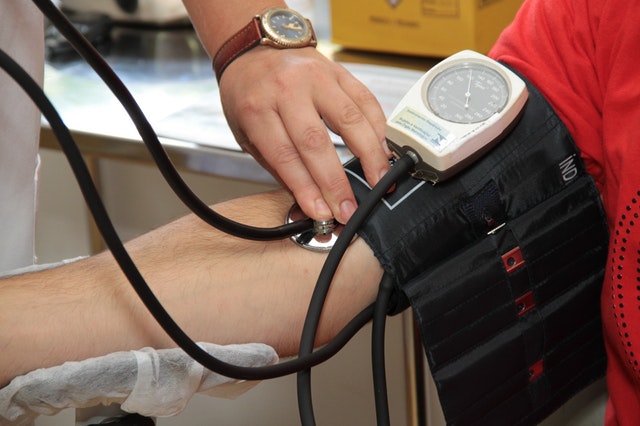Hypertension or High Blood Pressure
This particular ailment still remains the number one “silent killer!” It is called the “silent killer” because so many people don’t even know they have high blood pressure.

First Steps for Hypertension or High Blood Pressure
When you have elevated blood pressure you are at a higher risk for heart disease, kidney failure, stroke, and several other serious medical conditions. Hypertension affects both men and women, especially those in the African American community.
Although medication can be part of the solution, it is not the first step.
Step 1 – Monitor Your Blood Pressure!
If you do not know what your current blood pressure reading is or if you have not had your blood pressure taken in the last 6 months, then get to a local pharmacist, health clinic, or qualified medical professional. Have them take your blood pressure. This will be your baseline and will help to determine what your next step should be.
Your blood pressure will be given to you in two numbers such as 110/70 mm Hg. Your systolic number is the first and highest number. If this number is 140 or above then you have high blood pressure! Your diastolic number is the second and lowest number. If this number is 90 or above then you have high blood pressure! The higher above this threshold the greater your health risk.
Step 2 – Stop Smoking!
For many, this will be your hardest step but it is also the most important one to take. Smoking is also the number one risk factor for heart disease, stroke, and cardiovascular disease. It is estimated that 40% of all cardiovascular deaths are due to smoking.
Smoking will increase blood pressure. The carcinogenic components in tobacco damage the endothelial cells that line the walls of the arteries. This affects your nitric oxide production which we will talk about in Step 7. The carbon monoxide from the burned tobacco interferes with the blood’s ability to carry oxygen. This increases your heart rate and can raise your systolic blood pressure. Smoking also constricts the blood vessels in your arms and legs. This increases the resistance to blood flow which causes your diastolic blood pressure to increase.
Step 3 – Lose Weight!
Blood pressure rises with body weight. Obesity is one of the main reasons why hypertension is also at an all-time high. Losing weight can lower both your systolic and diastolic blood pressure. It is estimated that for every 20 pounds you lose, you can drop your systolic blood pressure by 5-20 points.
Because so many people have tried and failed at dieting, they see this category as hopeless. Diets are by their very nature restrictive and unproductive for long-term weight loss. So stop trying to diet. Learn how to apply weight management techniques that can have a profound effect on your health and blood pressure.
Step 4 – Exercise!
Properly applied aerobic exercises will strengthen your heart muscle, increase the diameter of the coronary arteries, and improve your lung function. This can have a very positive effect on lowering your blood pressure. As the heart muscle is strengthened it usually improves the efficiency of its contraction. This results in a great volume of blood being pushed out of the heart to improve blood flow. This will help to lower your systolic blood pressure when you are in the rest or non-exercise phase of your normal daily activities.
Exercise can also improve capillary function and helps to build additional capillary beds. This decreases resistance to blood flow and will help to lower your diastolic blood pressure. Most studies show that at least 30 minutes of moderate physical activity done 3 to 5 days per week can have a positive effect on your heart health and blood pressure.
Step 5 – Eat More Fruits & Vegetables!
The National Institutes of Health develop the DASH (Dietary Approaches to Stop Hypertension) diet to help lower your systolic blood pressure by 8-14 points. This dietary plan is low in fat, rich in fruits and vegetables, and moderate in animal protein.
A typical DASH eating plan includes:
• 4-5 servings of vegetables per day
• 4-5 servings of fruits per day
• 7-8 servings of whole grains per day
• 2-3 servings of low-fat or fat-free dairy per day
• 2 or fewer servings of lean meat, poultry, or seafood per day
• 4-5 servings of nuts, seeds, and beans per week
• 2-3 servings of fats and oils per day
This dietary approach is very similar to The Mediterranean Diet which has long been recognized as one of the best lifestyle approaches to reducing cardiovascular disease.
Both of these diets emphasize fruits and vegetables. More and more research is showing how beneficial the phytochemicals found in fruits and vegetables are to the function of the human body.
Phytochemicals:
• Act as antioxidants.
• Keep the walls of small blood vessels healthy.
• Make our small blood vessels stronger.
• Prevent platelets from becoming sticky causing them to pile up.
• Block specific enzymes that can raise blood pressure.
The incorporation of fruits and vegetables into your daily diet can have multiple health benefits.
Step 6 – Rebalance Your Mineral Intake!
Usually, this centers on reducing or eliminating salt from your diet. However, according to the Journal of the American Medical Association, reducing your sodium intake has a limited effect in reducing hypertension. Current research conducted in the United States is showing that moderate sodium intake combined with higher consumption of potassium, calcium, and magnesium offers greater benefits in reducing high blood pressure than just restricting sodium intake. The reason why is that these four minerals work together to help regulate blood pressure.
Fruits and vegetables such as bananas, tomatoes, avocados, dates, raisins, cantaloupe, oranges, and watermelon are rich sources of potassium. Low fat or non-fat sources of dairy products will help improve your calcium intake. Foods in their natural state contain less sodium than those that have been processed. Learning how to effectively rebalance your mineral intake will definitely help reduce hypertension.
Step 7 – Understand The Importance of Nitric Oxide!
To the general public nitric oxide is not very well known. To the medical community nitric oxide has been identified as the most important signaling molecule for the cardiovascular system. Very simply your cardiovascular system could not function properly without this critical molecule.
Nitric oxide regulates the muscle tone of blood vessels to have a major impact on controlling blood pressure. Through a series of enzymes, the endothelial cells that line your blood vessels create nitric oxide from the essential amino acid L-arginine. Over 10,000 citations have been compiled showing how important L-arginine is for the proper production of nitric oxide. Columbia University often refers to L-arginine as the “MAGIC BULLET” for the cardiovascular system.
Conclusion
These seven natural steps will go a long way in helping you take the hyper out of hypertension.
They all center on you taking a proactive approach to your health. They are all preventive in nature. Reducing the risk for age-related diseases depends upon your willingness to implement some simple, but profound, lifestyle changes. Until next time, may we both age youthfully!



